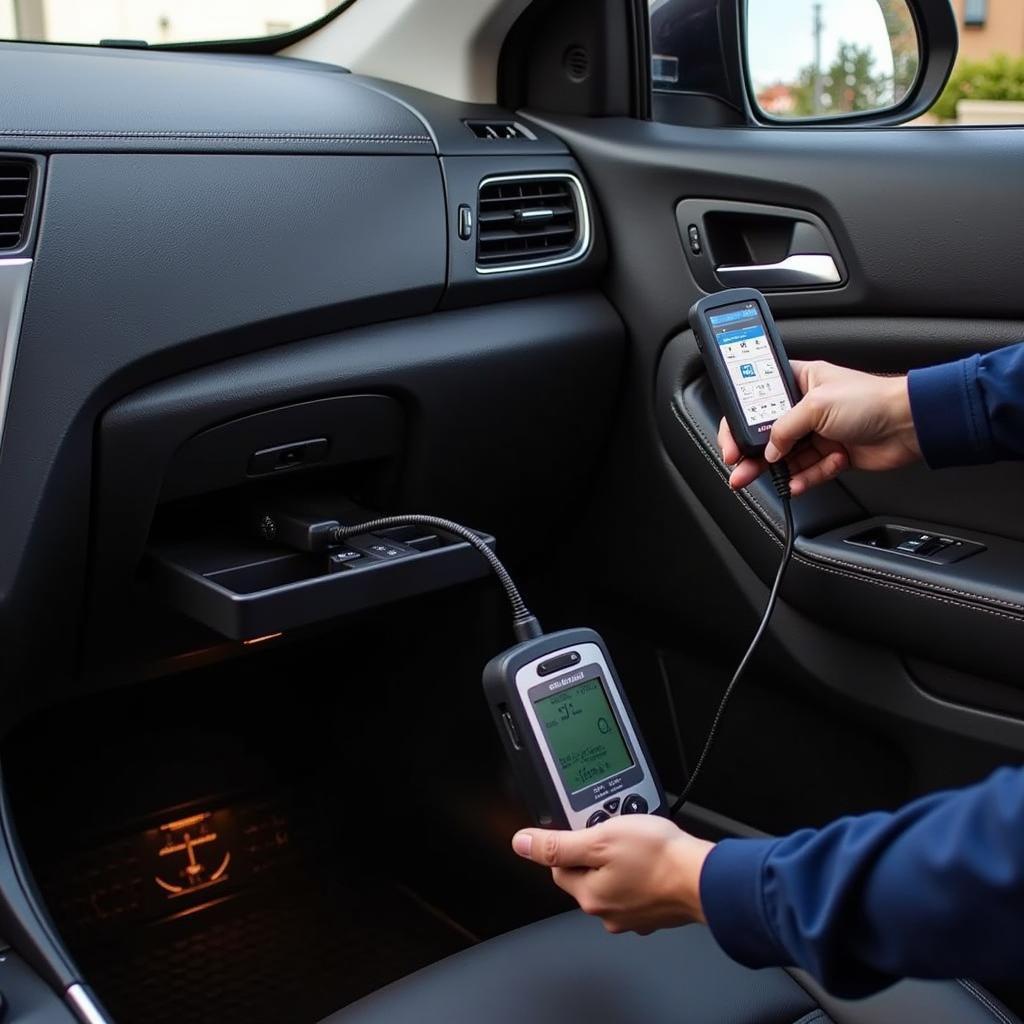A car diagnostic tool is a crucial piece of equipment for any car owner or mechanic. Understanding How Does A Car Diagnostic Tool Work can help you troubleshoot car problems effectively and potentially save you money on repairs. These tools, from simple code readers to advanced professional scanners, unlock the secrets hidden within your car’s computer system, providing valuable insights into its health and performance. Want to delve into the inner workings of these diagnostic marvels? Read on!
Decoding the Mystery: How a Car Diagnostic Tool Works
Car diagnostic tools act as a bridge between your car’s onboard computer, also known as the Engine Control Unit (ECU), and you. The ECU constantly monitors various sensors throughout the vehicle, collecting data on everything from engine temperature and fuel pressure to airbag status and anti-lock brake performance. When a problem arises, the ECU stores a diagnostic trouble code (DTC) in its memory. This is where the diagnostic tool comes in.
 Connecting a Car Diagnostic Tool to the OBD2 Port
Connecting a Car Diagnostic Tool to the OBD2 Port
The tool connects to your car through the OBD-II (On-Board Diagnostics, Second Generation) port, a standardized 16-pin connector. Once connected, it communicates with the ECU, retrieving the stored DTCs. These codes are then displayed on the tool’s screen, often accompanied by a brief description of the potential problem. Some advanced tools even provide live data streams, allowing you to monitor sensor readings in real-time.
Different Types of Car Diagnostic Tools: From Basic to Professional
Car diagnostic tools range from simple code readers available at auto parts stores to sophisticated professional-grade scanners used by mechanics. Basic code readers can retrieve and display DTCs, but their functionality is often limited. Advanced tools offer features such as live data streaming, bi-directional control (allowing you to activate certain components), and access to manufacturer-specific codes. Choosing the right tool depends on your needs and technical expertise. Looking for a reliable car opening tool? Check out the hpc goldfinger car opening tool.
What Does a Car Diagnostic Tool Tell You?
A car diagnostic tool can provide a wealth of information about your car’s health. Beyond retrieving DTCs, these tools can display freeze frame data, which captures the vehicle’s operating conditions at the moment a fault code was stored. This can be invaluable for diagnosing intermittent problems. They can also access manufacturer-specific codes, providing more detailed insights into the issue.
How to Use a Car Diagnostic Tool: A Step-by-Step Guide
Using a car diagnostic tool is generally straightforward, even for beginners. First, locate the OBD-II port, usually under the dashboard on the driver’s side. Next, turn the ignition to the “on” position (without starting the engine). Connect the diagnostic tool to the OBD-II port. The tool will power on and begin communicating with the ECU. Select the “read codes” or equivalent option on the tool’s menu. The tool will then retrieve and display any stored DTCs. Consult a repair manual or online resource to understand the meaning of the codes. If you’re interested in expanding your car tool collection, consider checking out our selection of tools kits for cars.
The Importance of Car Diagnostic Tools in Modern Vehicle Maintenance
Modern vehicles are increasingly complex, relying heavily on electronic systems. Car diagnostic tools have become essential for effective troubleshooting and maintenance. These tools can save you time and money by identifying problems early, preventing more costly repairs down the road. They empower car owners to take a more proactive approach to vehicle maintenance, ensuring optimal performance and reliability. Need specialized tools for a Mazda? Explore the d532 car tools mazda options available.
Conclusion: Empowering Car Owners with Diagnostic Knowledge
Understanding how a car diagnostic tool works is crucial in today’s automotive landscape. These tools provide valuable insights into your car’s health, empowering you to address issues effectively and potentially saving you money on repairs. Whether you’re a seasoned mechanic or a car enthusiast, a diagnostic tool is a must-have for maintaining and troubleshooting your vehicle. For those interested in car play integration tools, you might want to check out the nav tool car play 09 cts.
FAQ
- What is an OBD-II port? The OBD-II port is a standardized connector that allows access to a vehicle’s diagnostic data.
- Can I use any diagnostic tool on my car? Most modern cars use the OBD-II standard, but older vehicles may have different connectors.
- What are DTCs? DTCs are diagnostic trouble codes that indicate specific problems within a vehicle’s systems.
- Do I need a professional-grade diagnostic tool? Basic code readers are sufficient for retrieving DTCs, but advanced tools offer more features.
- Where can I find the meaning of DTCs? Repair manuals, online resources, and the diagnostic tool itself often provide descriptions of DTCs.
- Can a diagnostic tool fix my car? No, the tool only identifies problems. Repairs may still be necessary.
- Can I use a diagnostic tool to reset my check engine light? Yes, most diagnostic tools allow you to clear DTCs and reset the check engine light.
Common Scenarios
- Check Engine Light: A diagnostic tool can help pinpoint the cause of the check engine light, providing valuable information for repairs.
- Intermittent Problems: Freeze frame data can capture the vehicle’s operating conditions at the time of a fault, helping diagnose intermittent issues.
- Performance Monitoring: Live data streaming allows you to monitor sensor readings in real-time, providing insights into engine performance and other systems.
Further Exploration
Looking to expand your car maintenance knowledge? Explore these related topics:
- Understanding Car Sensors
- Advanced Diagnostic Techniques
- DIY Car Repairs
Need help with car diagnostics or looking for specific tools? Contact us via WhatsApp: +1(641)206-8880, Email: [email protected], or visit us at 910 Cedar Lane, Chicago, IL 60605, USA. Our 24/7 customer support team is ready to assist you. Did you know you can build your own mousetrap car? Explore these home training tools mousetrap car.

Leave a Reply